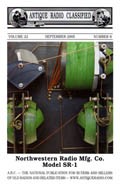Of Old Radios And Related Items--Published Monthly
VOLUME 22 SEPTEMBER 2005 NUMBER 9
EDITOR'S COMMENTS
From Antique Radio Classified for September 2005
(Copyright 1996-2005 by John V. Terrey - For personal use only.)"Please stop!" was the passionate plea of one reader who objected strenuously to our recent articles on "new stuff" -- the MP3 portables. Of course, we will continue to write about the new as well as the old, but our lead article and cover this month will certainly please that disgruntled reader. Thanks to Art Redman and his expert source Sonny Clutter, we take you back to 1921 and the birth of the Northwestern Radio Manufacturing Company in Charles L. Austin's backyard in Portland, Oregon. The company produced the basic battery sets well illustrated in the article, and it flourished until patent litigation initiated its demise in the Depression years.
This article also touches upon Charley Austin's biography and illustrates the kind of entrepreneurial spirit we associate with radio pioneers. Despite the ultimate failure of his company, Austin carried on with other communications projects, and seemed always ready to move on to the next challenge. Though not radio household names, Austin and his company are examples of the courage of those early manufacturers in taking the risk of investing in the new and exciting technology of radio.
And how rapidly this technology developed and changed! Within the next two decades, sets like the Philco 41-225, the subject of Richard Arnold's article, flooded the market. This 6-tube, AC set sported the latest trend -- push-button tuning -- which proved to be the most effective selling tool of the late 1930s.
Richard also points out that his set's push buttons still work very well. Since the company promised "long trouble-free operation," we have to conclude that there was some truth in advertising in those good old days.
Though the technology and styling in later decades took over the radio market, the 1920s linger on in collections, whether of obscure sets like Northwestern or radio-related postcards, like those from Erwin Macho in Vienna. These charming cards by artist W. Fialkowska are a follow-up to our February 2005 cover; however, at the time, we did not know his name. Again, another piece of information from a responsive reader like Erwin enriches us all.
Estes Auctions are a prime source of information for many of you readers, and so we are reluctant to disappoint you whenever our intrepid reporter Ray Chase can't cover a particular auction. Fortunately, Richard Estes himself has come up with two reports on events Ray missed. They were not record-breaking, but had respectable totals of $57,000 and $60,000. Items ranged from breadboards and other battery sets to cathedrals, tombstones, consoles, and communications equipment, some from Japan and Germany. Ray was back on the trail for spring auctions, so his reports will appear in future issues.
In Photo Review this month, Dave Crocker also contributes detailed information about a National receiver. In the spirit of A.R.C., Dave hopes that more info is forthcoming from you readers. Also shown are two similarly styled, "for the lady of the house" radios from the 1920s, one British, the other U. S.-made. They provoke thought about cabinet styles on each side of the "pond."
A.R.C. Benefits. Continue to take advantage of A.R.C. benefits: a toll-free number (866) 371-0512; Discover, MasterCard, American Express, Visa accepted; the Web, www.antiqueradio.com; books shipped free in the U. S. by USPS media mail; and for current subscribers, a 10 percent discount on all book orders.
Coming Radio Events. By the time you receive this issue, two big events of summer will have passed -- Radiofest and AWA. Let's hope you got to enjoy at least one of them. More are in the near future: 27 meetings, 8 meets, and one Estes auction. Two multiday meets will take place on opposite sides of the world -- Kutztown, Pennsylvania and Canberra, Australia. Perhaps our "down-under" correspondent Richard Begbie will send a report on the latter. Stay tuned.
Happy Collecting!
John V. Terrey, Editor
ON THE COVERInteriors are not usually featured on our cover, but this one of the Northwestern Radio Manufacturing Company's SR-1 receiver seemed too interesting and colorful to pass up. Though called a regenerative "receiver," this was really a tuner used in combination with the Type SR-2 detector/amplifier. This view shows the two variometers at the bottom of the panel and the primary circuit's tuning capacitor and variable inductor at the top. Thanks to Sonny Clutter for this photo!
Printed without comment
We continue to receive reports from advertisers of e-mail responses to their classified ads proposing to pay them with a check, sometimes via a third party, in excess of the purchase price. The seller is asked to refund the difference by wire. In more than one case reported to A.R.C., the check received was "bad."
To minimize problems, we suggest that you always know whom you are dealing with or ask for references.
| [Free Sample] [Books, etc., For Sale] [Subscribe to A.R.C./Renew] [Classified Ads] [Auction Prices] [Event Calendar] [Links] [Home] [Issue Archives] [Book Reviews] [Subscription Information] [A.R.C. FAQ] URL = http://www.antiqueradio.com/edcom09-05.html Copyright © 1996-2005 by John V. Terrey - For personal use only. Last revised: August 24, 2005. For Customer Assistance please contact ARC@antiqueradio.com or call (866) 371-0512 Pages designed/maintained by Wayward Fluffy Publications
Antique Radio Classified |
